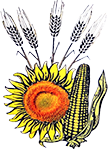The Additive Effect of 1RS:1AL Rye-Wheat Translocation and a QTL From 6A on TGW
Daniel Cristina, Alexandru-Leonard Dumitru, Matilda Ciucă
Institutul Național de Cercetare-Dezvoltare Agricolă Fundulea
Keywords: TGW, wheat, rye translocation, QTL, KASP.
Abstract: Wheat continues to be one of the most important crops worldwide. The continuous changes of climate, land and water availability and other factors influence the yielding capability of wheat cultivars. Exploitation of genetic variation for thousand-grain weight (TGW) and related traits is a promising approach to improve wheat yield in wheat breeding programs.
Wheat improvement using alien substitutions or translocations of chromosomes between wheat and its relative species played an important role in wheat breading programs. One of the most valuable relative species for the improvement of wheat productivity, adaptive possibilities, and disease and insect resistance is represented by rye (Secale cereale L.).
In this study, 192 DH lines, selected from the cross of cultivar Izvor with F000628G34 line that carry the 1RS:1AL translocation, were phenotyped along five years for TGW (2014-2018) and genotyped with SSR marker TSM106 (for rye translocation detection) and the KASP marker BS00023089, associated with a QTL for TGW (chromosome 6A).
The genotyping revealed four groups of DH lines, 69 lines with 1RS:1AL translocation and the favorable allele for the QTL (SNP G), 57 lines with 1RS:1AL translocation, 34 lines with the favorable allele for the QTL and 32 lines without any favorable element.
The results showed that the average TGW for the group of DH lines that had the 1RS:1AL translocation and the favorable allele for the QTL was higher than that of other groups that only had one favorable genetic element, and of course, these three groups were superior to the group without any favorable element, highlighting the additive effect of these loci.
The mean differences of TGW between the DH lines groups, respectively, the group with 1RS:1AL+QTGW, 1RS:1AL, QTGW, and the group without any favorable elements, were 5.7, 4.0 and 3.2 g.
